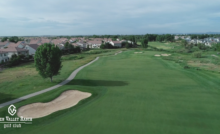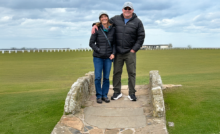Golf,Environmentally Friendly?
Truckee, California is located about 12 miles North of Lake Tahoe in the Sierra Nevada Mountains. At an elevation of roughly 6,000 feet, our area receives approximately 300 inches of snow every year from October through April with a golfing season of mid May (I’ve opened in June on some years) to about the third week in October. The one thing I know after 18 years of residing here is that no winter (or spring) is the same and our summers are mild with little to no precipitation or humidity. We are lucky to have minimal or no insect pressure and almost no summer disease. Our Kentucky bluegrass fairways have never been sprayed for either one. On the other hand, snow mold diseases run rampant and ice damage can devastate the turf on any given year.
In September of 1999, after eight-and-a-half years as Superintendent at Tahoe Donner Golf Course, I took an exciting opportunity to build a new course down the street called Coyote Moon. The topography and layout of the course was the best I had seen in the area, and to this day, is the favorite mountain course to many who have played here. Working with the owner and architect to keep our construction costs to a minimum (value engineering) we agreed to keep the number of irrigated acres to as little as possible and ended up with 65 acres of turf. In the long run, this decision has made the course unique from the aspect of shot placement and esthetics, but more importantly for the environment. With only 65 acres of turf on over 200 acres of land, the impact of fertilizer quantities, pesticide applications and water usage are minimal.
Grassing specifications can also give you the power to eliminate or reduce these uses. I chose a blend of six varieties of Kentucky bluegrass for fairways, tees and rough because of its hardiness for a cold and snowy climate and its resistance and recovery to snow mold disease. Researching the NTEP studies helped me custom blend a Bent grass blend for the greens of 50% SR1019 and 50% SR1119. Both varieties showed good cold tolerance and resistance to snow mold. Eliminating the need for extensive, long term maintenance will save you money and benefit the environment, so it’s a win-win.
I wasn’t sure which direction I was going when the owner of Coyote Moon leased the golf course to a new developer who showed up in our sleepy little town. Either way, I was along for the ride, and East West Partners became my new employer. We started construction in 2002 on a new course called Old Greenwood, which is a Jack Nicklaus Signature Design.
Our focus was to build the course as environmentally-friendly as technology allows. We started by partnering with Audubon International in their Gold Signature Program, which involves proactive requirements prior to final plans. Much of Audubon’s criteria are based on water quality, ensuring that ground and surface water are never affected by nutrients or pesticides. Surface water is never allowed to directly enter a body of water. Instead, it contours fairways that border water bodies to sheet flow to drains. It is a very simple solution to avoid runoff contamination. All drainage on the course has to “day-light” through a vegetative swale before it goes into a body of water, or drain into a gravel sump or settlement basin. Littoral shelves were constructed along the edges of the ponds to harbor aquatic vegetation which in turn helps to use up any natural nutrients in the water, which helps the water quality as well.
Prior to design, a wildlife study was done to ensure that migrating mammals were given plenty of room to roam through the property. Several key wildlife corridors where incorporated into the design to help our deer and other animals roam naturally. Bird boxes were constructed and placed in strategic locations for the numerous species of song birds found on site. The nest boxes are surveyed annually, and the information that is gathered is used in a national census. Throughout construction, I was known as the “native Nazi” for keeping as many trees, stumps, snags and native plant material untouched to enhance wildlife habitat. No equipment was allowed outside of the clearing limits of each hole, and rerouting pipe runs to save trees was a daily occurrence.
Another principle value in our Natural Resource Management Plan (NRMP) written by Audubon International is Integrated Pest Management. Many scientific and common-sense practices are used to eliminate or reduce pesticide use, inhibit the mobility of nutrients and provide the proper product for our climate. Having a certain threshold for the number of broadleaf weeds within a given area is one example. Once the threshold is met, a herbicide can be used with a backpack sprayer. This process greatly reduces the amount of herbicide used versus broadcast spraying the entire fairway, and even after five seasons our course remains virtually weed-free. Fertilizers that are used on the course must be organic or slow-release to avoid possible leaching into the ground water. Spring and fall applications of poultry-based fertilizer are used to build the soil, and one summer application of slow-release synthetic will hold our color throughout the golfing season. Building healthy soil can greatly reduce the amount of nitrogen needed and save money. Old Greenwood opened in the fall of 2004, and on September 14, 2005, we became the first Audubon International Certified Gold Signature Sanctuary golf in the state of California.
Two-thousand five also brought the start of construction to our sister course, The Golf Club at Gray’s Crossing. This course was a planned private design by Peter Jacobsen and Jim Hardy, and also done with the aid of our environmental mentor, Audubon International. All of the same planning and practices went into the course as well, but we had a sharper pencil this time to do an even better job with construction. We stuck to our grassing specifications but we used less of it. The course has more of a “links” feel, with native grasses surrounding the tee complexes and hints of wildflowers along the edges of each hole. Care was taken to keep all wetlands undisturbed with barriers and silt fence surrounding the perimeters of all native wetlands. Bridges were built over these wetlands without any equipment touching the ground and the piping and electrical were routed underneath. When we opened the course in July of 2007, it looked like the course had been “placed’ in its native surrounding of Pine, Sage and Bitterbrush. Gray’s Crossing became the second Certified Gold Audubon International Signature Sanctuary in the state of California on September 12, 2007.
Golf and the environment can definitely go hand in hand, and our courses are just an example of how that can happen. Courses around the nation (including ours) can always strive to do a better job being stewards of the environment. Superintendents and owners alike play a crucial role in the way their facilities are managed and perceived. Gone are the days of heavy metal fungicides and toxic chemicals. Technology is our friend and so is our environment.
Recent Posts
Coxreels® Exceeds Industry Recommended Salt Spray Testing Hours
Due to its numerous properties and, specifically, its corrosion resistance, powder coating is used for…
Advanced Turf Solutions and Arborjet | Ecologel Announce Strategic Partnership
Advanced Turf Solutions (ATS) is pleased to announce a new strategic partnership with Arborjet |…
BRANDT Expands Cup Format For Superintendents in Florida
The Florida Golf Course Superintendents Association proudly announces an extension and expansion of its successful…
The Rare Condor: What It Means for Golf and the Course Maintenance Behind It
Imagine this: you're on a par-5, having just hit your shot toward the green. You…
DENIOS Under Bench Cabinet Provides Safe Storage of Lithium-Ion Batteries
DENIOS introduces asecos under bench cabinets for the safe storage of undamaged lithium-ion batteries. They…
True Blue Golf Club, One of America’s Top 100 Resort Courses, Acquires Steve Dresser Golf Academy
True Blue Golf Club has acquired the Steve Dresser Golf Academy, a renowned instructional facility…



